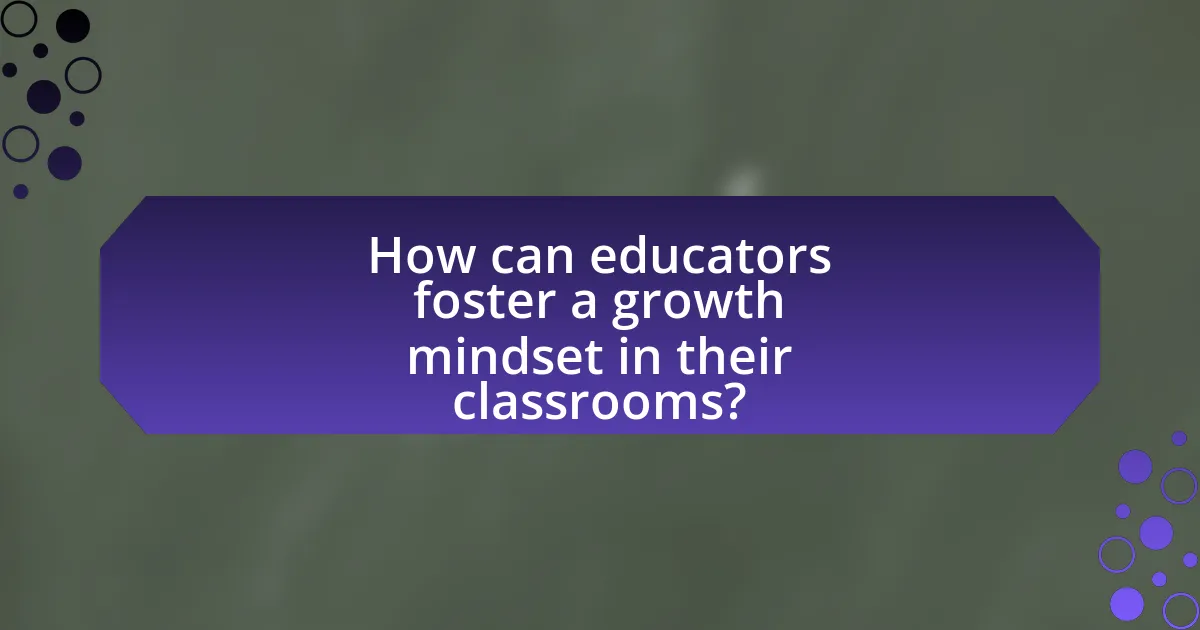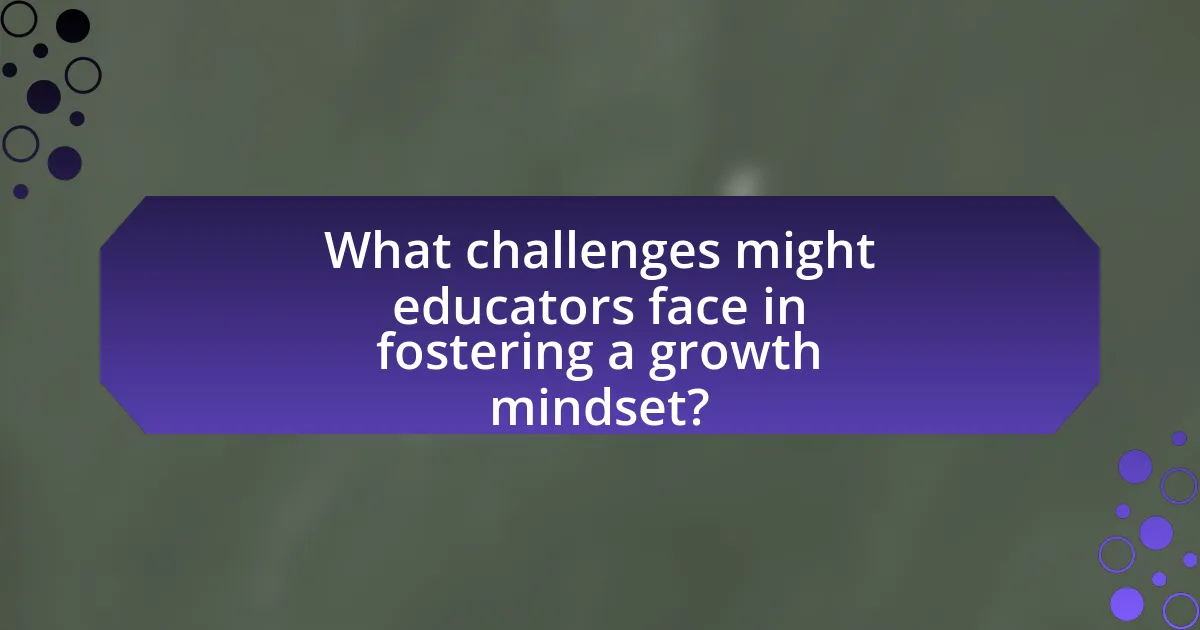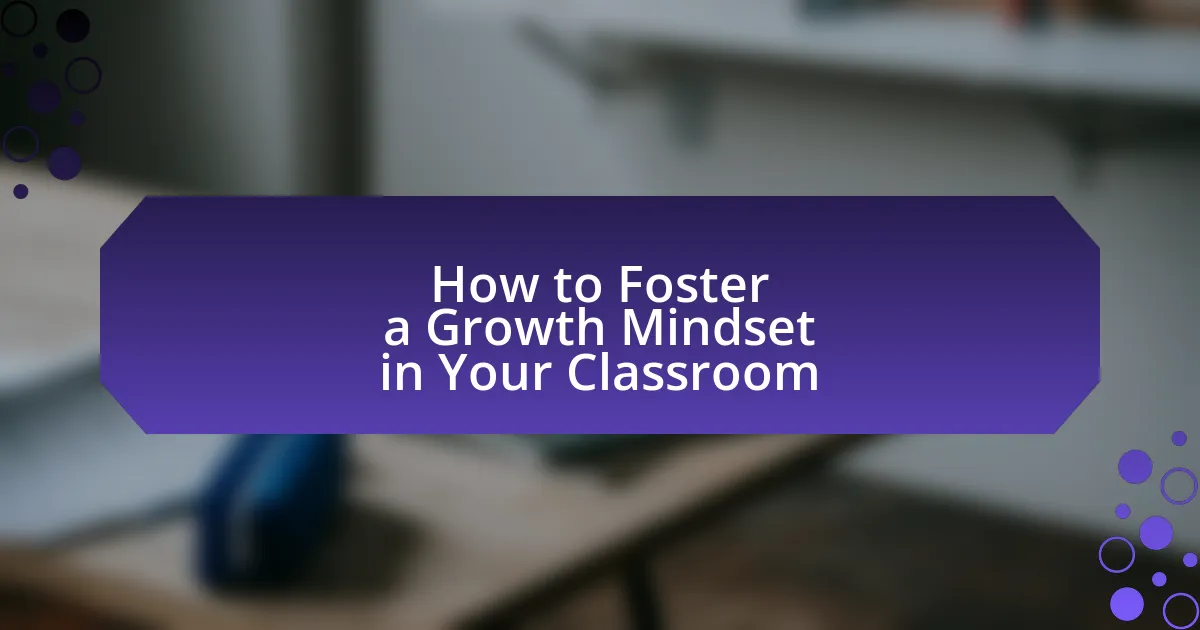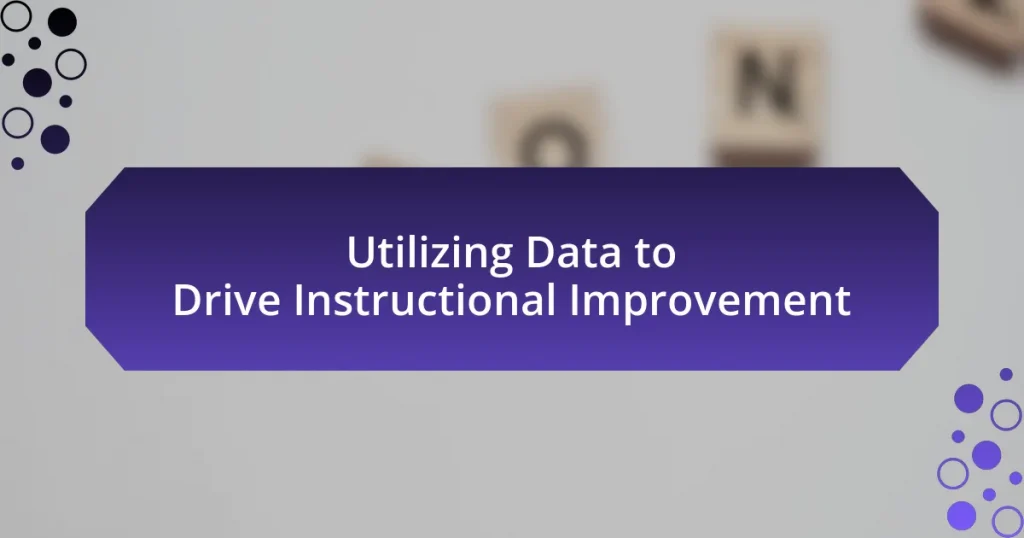The article focuses on fostering a growth mindset in the classroom, defined as the belief that students can enhance their abilities and intelligence through effort and persistence. It contrasts growth and fixed mindsets, highlighting the importance of resilience, motivation, and viewing challenges as opportunities for learning. Key strategies for educators include promoting effort over innate talent, providing constructive feedback, and creating a supportive classroom environment that encourages collaboration and risk-taking. The article also addresses potential challenges educators may face, misconceptions about growth mindset, and methods for measuring its effectiveness in enhancing student learning outcomes.

What is a Growth Mindset in the Classroom?
A growth mindset in the classroom is the belief that students can develop their abilities and intelligence through effort, learning, and persistence. This concept, popularized by psychologist Carol Dweck, emphasizes that challenges and failures are opportunities for growth rather than indicators of inability. Research shows that students with a growth mindset are more likely to embrace challenges, persist in the face of setbacks, and achieve higher academic performance. For instance, a study published in the journal “Psychological Science” found that students who were taught about growth mindset principles improved their math scores significantly compared to those who were not.
How does a growth mindset differ from a fixed mindset?
A growth mindset differs from a fixed mindset in that individuals with a growth mindset believe their abilities and intelligence can be developed through effort and learning, while those with a fixed mindset believe their abilities are static and unchangeable. Research by psychologist Carol Dweck indicates that individuals with a growth mindset are more likely to embrace challenges, persist through difficulties, and view failures as opportunities for growth, whereas those with a fixed mindset may avoid challenges and feel threatened by the success of others. This distinction is crucial in educational settings, as fostering a growth mindset can lead to improved student motivation and achievement.
What are the key characteristics of a growth mindset?
A growth mindset is characterized by the belief that abilities and intelligence can be developed through dedication and hard work. Individuals with a growth mindset embrace challenges, persist in the face of setbacks, see effort as a path to mastery, learn from criticism, and find inspiration in others’ success. Research by Carol Dweck, a psychologist at Stanford University, supports these characteristics, demonstrating that students with a growth mindset achieve higher academic performance and are more resilient in their learning processes.
Why is understanding mindset important for educators?
Understanding mindset is crucial for educators because it directly influences student motivation, learning outcomes, and resilience. Research by Carol Dweck, a leading psychologist in the field, demonstrates that students with a growth mindset—believing their abilities can improve through effort—tend to achieve higher academic success compared to those with a fixed mindset. This understanding allows educators to create a supportive learning environment that encourages risk-taking and perseverance, ultimately fostering a culture of continuous improvement and achievement in the classroom.
What role does a growth mindset play in student learning?
A growth mindset significantly enhances student learning by fostering resilience and a willingness to embrace challenges. Students with a growth mindset believe that their abilities can improve through effort and learning, which leads to increased motivation and persistence in the face of difficulties. Research by Carol Dweck, a leading psychologist in this field, demonstrates that students who adopt a growth mindset are more likely to engage in learning activities, seek feedback, and ultimately achieve higher academic performance. This mindset encourages a focus on the learning process rather than solely on outcomes, promoting a deeper understanding of the material and a greater likelihood of long-term success in education.
How can a growth mindset influence student motivation?
A growth mindset can significantly enhance student motivation by fostering resilience and a willingness to embrace challenges. When students believe that their abilities can improve through effort and learning, they are more likely to engage in tasks, persist in the face of difficulties, and seek out feedback. Research by Dweck (2006) indicates that students with a growth mindset are more likely to take on challenging assignments and view failures as opportunities for growth, which directly correlates with increased motivation and academic achievement. This mindset shift encourages students to focus on the learning process rather than solely on outcomes, leading to a more sustained and intrinsic motivation to learn.
What impact does a growth mindset have on academic performance?
A growth mindset positively impacts academic performance by enhancing students’ resilience and motivation to learn. Research indicates that students with a growth mindset are more likely to embrace challenges, persist through difficulties, and view effort as a path to mastery. For instance, a study by Dweck (2006) found that students who believed their abilities could improve through effort achieved higher grades and demonstrated greater academic achievement compared to those with a fixed mindset. This mindset fosters a love for learning and a willingness to take risks, ultimately leading to improved academic outcomes.

How can educators foster a growth mindset in their classrooms?
Educators can foster a growth mindset in their classrooms by promoting the belief that abilities can be developed through dedication and hard work. This can be achieved by incorporating strategies such as praising effort rather than innate talent, encouraging students to embrace challenges, and teaching them to view failures as opportunities for learning. Research by Carol Dweck, a leading psychologist in this field, demonstrates that students who are taught about growth mindset principles show increased resilience and improved academic performance. By implementing these practices, educators create an environment that supports continuous learning and personal development.
What strategies can teachers implement to promote a growth mindset?
Teachers can implement strategies such as providing constructive feedback, encouraging risk-taking, and modeling a growth mindset themselves to promote a growth mindset in students. Constructive feedback helps students understand that effort leads to improvement, while encouraging risk-taking allows them to embrace challenges without fear of failure. Additionally, when teachers model a growth mindset by sharing their own learning experiences and emphasizing the value of persistence, they create an environment that fosters resilience and a love for learning. Research by Dweck (2006) highlights that students who believe their abilities can be developed through dedication and hard work tend to achieve higher academic success.
How can feedback be used to encourage a growth mindset?
Feedback can be used to encourage a growth mindset by providing specific, constructive insights that focus on effort and improvement rather than innate ability. When educators deliver feedback that emphasizes the process of learning, such as highlighting strategies used or progress made, it reinforces the idea that skills can be developed over time. Research by Dweck (2006) indicates that students who receive feedback that praises effort and resilience are more likely to embrace challenges and persist in the face of setbacks, thereby fostering a growth mindset. This approach not only motivates students but also helps them understand that their abilities can evolve through dedication and hard work.
What role does goal-setting play in developing a growth mindset?
Goal-setting plays a crucial role in developing a growth mindset by providing clear objectives that encourage individuals to embrace challenges and learn from failures. When students set specific, measurable, achievable, relevant, and time-bound (SMART) goals, they create a roadmap for their learning journey, which fosters resilience and adaptability. Research by Dweck (2006) indicates that individuals who engage in goal-setting are more likely to view challenges as opportunities for growth rather than obstacles, reinforcing the principles of a growth mindset. This process not only enhances motivation but also cultivates a belief in the ability to improve through effort and persistence.
How can classroom environment support a growth mindset?
A classroom environment can support a growth mindset by promoting a culture of learning, where mistakes are viewed as opportunities for growth. This environment encourages students to take risks and embrace challenges, fostering resilience and perseverance. Research by Carol Dweck, a leading psychologist in the field of motivation, highlights that students who perceive their abilities as improvable are more likely to engage in learning and develop a growth mindset. Additionally, incorporating collaborative learning activities allows students to learn from one another, reinforcing the idea that effort and strategy lead to improvement.
What are the elements of a growth-oriented classroom culture?
A growth-oriented classroom culture includes elements such as a focus on effort over innate ability, encouragement of risk-taking, and fostering a supportive environment for collaboration. These elements promote resilience and a positive attitude towards learning. Research indicates that classrooms emphasizing effort lead to higher student achievement, as demonstrated in studies by Dweck (2006) which show that students with a growth mindset are more likely to embrace challenges and persist through difficulties. Additionally, creating a safe space for collaboration allows students to learn from one another, enhancing their understanding and skills.
How can collaboration among students enhance a growth mindset?
Collaboration among students enhances a growth mindset by fostering an environment where they can share ideas, learn from each other, and develop resilience through collective problem-solving. When students work together, they encounter diverse perspectives that challenge their thinking and encourage them to embrace challenges rather than avoid them. Research indicates that collaborative learning experiences can lead to improved academic performance and increased motivation, as students feel supported by their peers. For instance, a study published in the “Journal of Educational Psychology” by Johnson and Johnson (2014) found that cooperative learning strategies significantly enhance students’ attitudes toward learning and their belief in their ability to grow and improve. This evidence supports the notion that collaboration not only builds social skills but also reinforces the principles of a growth mindset.

What challenges might educators face in fostering a growth mindset?
Educators may face several challenges in fostering a growth mindset, including resistance from students, ingrained fixed mindsets, and a lack of resources or training. Resistance from students can stem from previous experiences where they were praised for innate ability rather than effort, making it difficult for them to embrace the concept of growth. Additionally, many students may have developed a fixed mindset due to societal or familial beliefs that emphasize talent over hard work. Furthermore, educators often lack adequate training or resources to effectively implement growth mindset strategies in their classrooms, which can hinder their ability to model and teach these principles effectively. Research by Dweck (2006) highlights that without proper support and understanding, both educators and students may struggle to shift their perspectives towards a growth-oriented approach.
What common misconceptions about growth mindset should be addressed?
Common misconceptions about growth mindset include the belief that it is solely about positive thinking, that it guarantees success, and that it can be developed overnight. Positive thinking alone does not lead to a growth mindset; it requires effort, learning from failures, and persistence. Research by Dweck (2006) indicates that while a growth mindset can enhance learning and resilience, it does not automatically ensure success without the application of strategies and hard work. Additionally, developing a growth mindset is a gradual process that involves consistent practice and reflection, not an instantaneous change.
How can resistance to change be managed in the classroom?
Resistance to change in the classroom can be managed by fostering open communication and involving students in the change process. When educators clearly articulate the reasons for change and actively seek student input, it creates a sense of ownership and reduces anxiety associated with new methods. Research indicates that when students feel heard and valued, their willingness to adapt increases, as shown in studies by Dweck (2006) on growth mindset, which emphasizes the importance of student engagement in learning processes. Additionally, providing support and resources during transitions can further alleviate resistance, as students are more likely to embrace change when they feel equipped to handle it.
What strategies can help overcome student skepticism about growth mindset?
To overcome student skepticism about growth mindset, educators can implement strategies such as providing explicit instruction on the growth mindset concept, sharing success stories of individuals who have benefited from adopting this mindset, and incorporating regular feedback that emphasizes effort and improvement. Research by Carol Dweck, a leading psychologist in this field, shows that when students understand that abilities can be developed through dedication and hard work, they are more likely to embrace challenges and persist in the face of setbacks. Additionally, creating a classroom environment that celebrates mistakes as learning opportunities can further reinforce the growth mindset, as it shifts the focus from performance to learning.
How can educators measure the effectiveness of growth mindset initiatives?
Educators can measure the effectiveness of growth mindset initiatives through pre- and post-intervention assessments that evaluate student attitudes towards learning and resilience. These assessments can include surveys that gauge students’ beliefs about their abilities, as well as academic performance metrics such as grades and standardized test scores. Research by Dweck (2006) indicates that students with a growth mindset show increased motivation and achievement, supporting the use of these metrics to assess initiative effectiveness. Additionally, qualitative feedback from students and teachers can provide insights into changes in classroom dynamics and student engagement, further validating the impact of growth mindset initiatives.
What tools and assessments can be used to evaluate mindset development?
Tools and assessments that can be used to evaluate mindset development include the Mindset Assessment Profile, Growth Mindset Survey, and the Dweck Mindset Scale. The Mindset Assessment Profile, developed by researchers, measures individuals’ beliefs about their abilities and potential for growth. The Growth Mindset Survey, created by Carol Dweck, assesses students’ attitudes towards learning and challenges. The Dweck Mindset Scale quantifies the degree to which individuals endorse a growth versus fixed mindset. These tools provide concrete metrics for educators to gauge mindset development in students, facilitating targeted interventions to foster a growth mindset in the classroom.
How can educators gather feedback from students on mindset practices?
Educators can gather feedback from students on mindset practices through surveys, interviews, and reflective journals. Surveys can include specific questions about students’ perceptions of their growth mindset, allowing for quantitative analysis of attitudes. Interviews provide qualitative insights, enabling educators to explore students’ thoughts in depth. Reflective journals encourage students to articulate their experiences and challenges related to mindset practices, fostering self-awareness. Research indicates that student feedback is crucial for improving teaching strategies and enhancing learning outcomes, as highlighted in the study “The Role of Student Feedback in Enhancing Learning” by Hattie and Timperley, which emphasizes the importance of feedback in educational settings.
What are some practical tips for implementing a growth mindset in the classroom?
To implement a growth mindset in the classroom, educators should encourage students to embrace challenges and view failures as opportunities for learning. This can be achieved by praising effort rather than innate ability, which reinforces the idea that skills can be developed through hard work. Research by Carol Dweck, a leading psychologist in this field, shows that students who receive praise for their effort are more likely to take on challenges and persist in the face of difficulties. Additionally, incorporating reflective practices, such as journaling about learning experiences, helps students recognize their progress and understand that growth is a continuous process.



